
The Queen's Own Royal West Kent Regiment was a line infantry regiment of the British Army based in the county of Kent in existence from 1881 to 1961. The regiment was created on 1 July 1881 as part of the Childers Reforms, originally as the Queen's Own , by the amalgamation of the 50th Regiment of Foot and the 97th Regiment of Foot. In January 1921, the regiment was renamed the Royal West Kent Regiment and, in April of the same year, was again renamed, this time as the Queen's Own Royal West Kent Regiment.

The Queen's Westminsters were an infantry regiment of the Territorial Army, part of the British Army. Originally formed from Rifle Volunteer Corps, which were established after a French invasion scare of 1859. The unit became part of the newly established London Regiment on the formation of the Territorial Force in 1908. It was subsequently amalgamated in 1921 with the Civil Service Rifles, and became a territorial Battalion of the King's Royal Rifle Corps in 1937. It ceased to exist as separate entity after it was amalgamated in 1961.
The 133rd Infantry Brigade was an infantry brigade of the British Army that saw service during the First World War in British India, but never as a complete formation. In the Second World War, the brigade fought in the Battle of France in May 1940 and was evacuated at Dunkirk. It later fought in the North African Campaign, and was disbanded on 1 January 1943.

RADA Studios is a theatrical venue in Chenies Street in Bloomsbury, just to the east of Tottenham Court Road in the West End of London. Owned by the Royal Academy of Dramatic Art (RADA), the building contains rehearsal rooms, meeting rooms, and the 200-seat Studio Theatre.
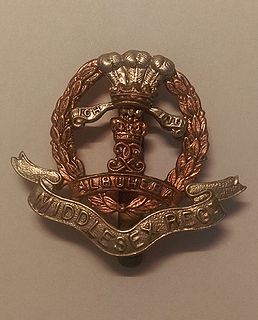
The Middlesex Regiment was a line infantry regiment of the British Army in existence from 1881 until 1966. The regiment was formed, as the Duke of Cambridge's Own , in 1881 as part of the Childers Reforms when the 57th and 77th Regiments of Foot were amalgamated with the county's militia and rifle volunteer units.
The Royal East Kent Yeomanry was a British Army regiment formed in 1794. It saw action in the Second Boer War and the First World War.

The Queen's Own West Kent Yeomanry was a British Army regiment formed in 1794. It served in the Second Boer War and the First World War. It amalgamated with the Royal East Kent Yeomanry to form the Kent Yeomanry in 1920.
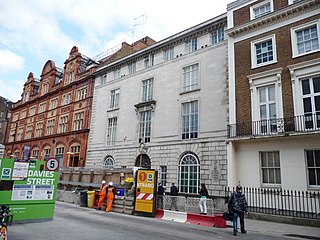
The Davies Street drill hall is a former military installation in Davies Street, London.

Blackheath drill hall is a military installation at Blackheath in London.

The St John's Hill drill hall is a military installation at Lavender Hill in London. The building on St John's Hill became the regimental headquarters for the London Regiment in 1993.
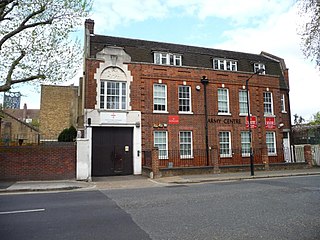
The Braganza Street drill hall is a military installation in Braganza Street, Walworth.

The Mitcham Road Barracks is an Army Reserve centre in Croydon, London, with a history dating back to 1794.

The Phoenix Street drill hall is a former military installation in Lancaster, Lancashire.

Londesborough Barracks is a military installation in Kingston upon Hull, England.

The St Paul's Street drill hall is a military installation in Huddersfield, West Yorkshire. It is a Grade II listed building.
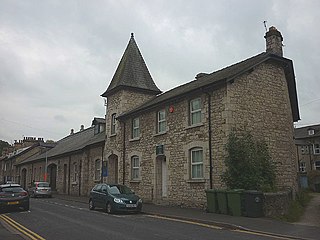
The Queen Katherine Street drill hall, sometimes known as the Aynam Road drill hall is a military installation located in Queen Katherine Street, off Aynam Road, in Kendal, Cumbria, England.
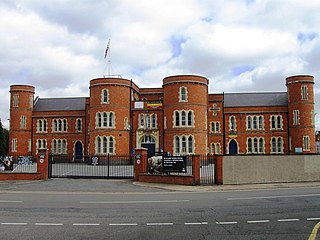
The Clare Street drill hall is a military installation in Northampton, Northamptonshire. It is a Grade II listed building.

The Corn Exchange is a former chapel, trading facility and military installation at Bank Street in Tonbridge, Kent.
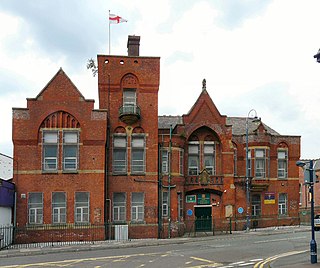
The Old Street drill hall is a former military installation in Ashton-under-Lyne, Greater Manchester, England.

24th Battalion was a battalion of the London Regiment (1908-1938). Between 1908 and 1938 it was based at the Braganza Street drill hall, though in 1914 it mobilised for war at 71 New Street, Kennington Park Road.



















